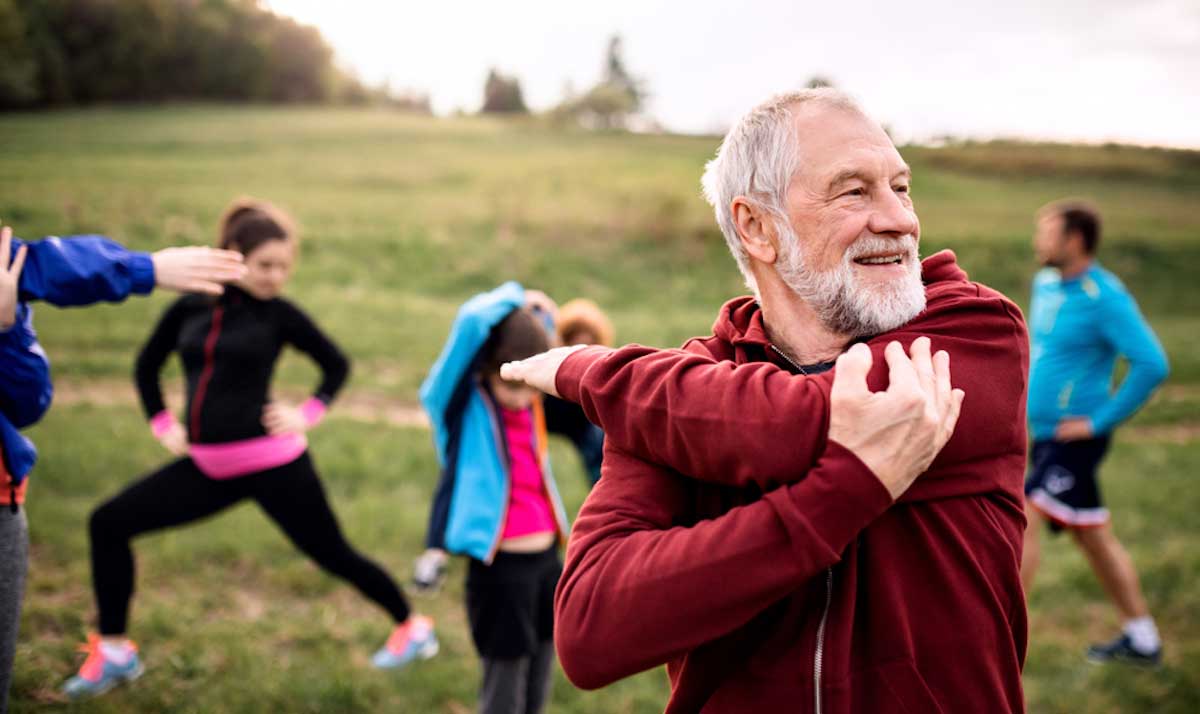Aging is an inevitable part of life, but the way our bodies age can vary greatly between individuals. Much of this disparity is related to the care one takes in regularly performing healthy practices to maintain their physical condition. Good nutrition, regular stretching, and careful exercise are the essential components of a healthy regimen as we age. This is especially important for those with an active lifestyle, as aging does increase the potential for injury.
Let’s face it—nutrition is the cornerstone of health! Quite literally, “you are what you eat,” as every nutrient you intake is reconstituted into the tissues of your body. Taking a daily multivitamin to broadly cover your nutrient requirements is good practice, but antioxidant and nutrient-rich foods are irreplaceable. Feeding the slow-growing tendons and ligaments is paramount to reducing the tendency toward injury that occurs as they stiffen with age.
According to the National Cancer Institute, examples of nutrient-dense foods worth building a diet around include:
- Fruits and vegetables
- Legumes
- Whole grains
- Nuts
- Low-fat or fat-free dairy products
- Seafood
- Lean meat
- Eggs
Regular Stretching Does Wonders for Your Body
Regular stretching helps to maintain flexibility where injuries are prone. The achilles tendon is particularly susceptible, and debilitating when injured. Below we’ve outlined a few stretches you can practice daily to increase and maintain flexibility—and just feel better when you move!
Heel Drop
- Find a stair or similar stable platform.
- Hold onto the railing of the staircase or find another way to support yourself.
- Place the ball of one of your feet on the edge of the stair or platform.
- While holding on for support, slowly let your heel drop down past the stair and feel the stretch in your calf.
- Gently bring your heel back up, and then switch to the other foot.
- Repeat as many times as it feels comfortable.
Runner’s Stretch/Calf Stretch
- Stand facing a wall and place your hands on the wall at eye level.
- Step back with one leg while keeping both heels on the floor.
- Bend the knee of the leg in front. You should feel the stretching in your calf.
- Hold the stretch for roughly 15 seconds, then switch to the other leg.
- Repeat as many times as it feels comfortable.
Sitting Heel Raises
- Sit in a chair and place both feet flat on the floor.
- Without lifting your toes, lift your heels off the floor as high as you can.
- Hold the stretch for 10–15 seconds, then switch to the other heel.
- Repeat as many times as it feels comfortable.
Another helpful exercise for older athletes is the so-called “flamingo stand”. Standing on one foot for 15 seconds or so at a time improves balance and strengthens the muscles associated with standing. Balance and lower body strength are key in reducing injury for active adults!
More recent literature has also moved away from the age-old idea of stretching prior to exercise, recommending a more general warm-up period instead. Stretching is best performed throughout the day, several times a week, along with plenty of rest between workouts. The rest period is essential for recovery, and takes longer with age. Don’t be afraid to give your body that extra day.
Take a Gentler Approach to Exercise as You Age

While regular exercise provides huge benefits for health and wellbeing, age necessitates a gentler approach to avoid orthopaedic injury. Ample rest time with occasional strength training are a powerful combination to support regular activity, such as golf, tennis, and other physical activities.
In addition, focusing on core strength forms a strong base for the rest of the body. Most muscles rely on the core to complete a motion, and a strong core ensures movements are well supported to reduce the risk of injury. Harvard Health particularly recommends the bridge, plank, and opposite arm and leg raise for core strength.
The squat is a powerful movement for the lower body, and assists with balance and strengthening the core. It is performed by standing with feet shoulder-width apart, and moving to a seated position with legs parallel to the ground, then returning to a stand. This engages the core, and strengthens its connection to the lower body. The shoulders see heavy use in activities involving the upper body, and the rotator cuff is particularly injury-prone. Regularly stretching this area helps to maintain range of motion, and adding in strength exercises can help prevent the not-uncommon injuries that many experience for the first time with advancing age.
Make Self Care a Priority for Comfortable Aging
The aging process naturally results in a gradual increase in susceptibility to injury, but can be greatly reduced with good practices and care for oneself. A healthy, energetic routine should be accompanied by an attention to the twinges of taking it too far. Injuries are painful, and will take longer to heal in older adults. Good nutrition, stretching, and exercise support the body by preparing for more strenuous activities, and giving it the nutrients to repair the wear and tear of daily life.
If you’ve experienced an injury, or have been living with pain from an orthopaedic condition such as arthritis, it’s worth it to come see one of our specialist orthopaedic doctors to assess your treatment options. Contact us to request an appointment today!
